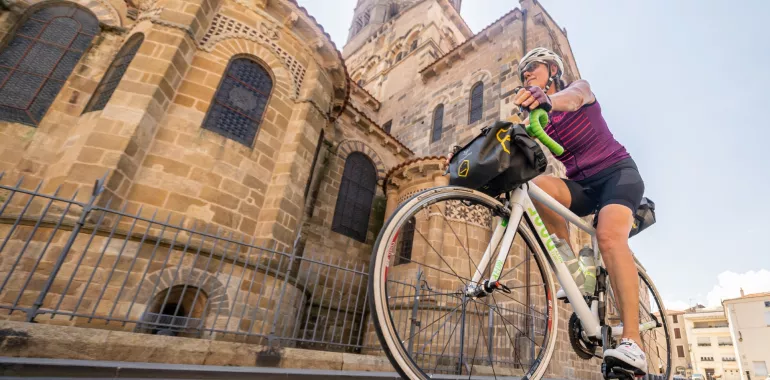
27,15 km cycling route from Issoire to Brassac-les-Mines
Elevation of the stage
Waytypes of the stage
Surface of the stage
The route along the Via Allier from Issoire to Brassac-les-Mines
Leaving Issoire, rejoin the Via Allier by following the link signposted "accès V70 sud" up to Varennes-sur-Usson, going along the D996 road, passing through Parentignat. Crossing the Allier River, you come close to the suspension bridge here over the Allier. Once back on the cycle route, continue via Saint-Rémy-de-Chargnat, Saint-Martin-de-Plains and Orsonnette before crossing the Allier River once again, at Saut-du-Loup and the confluence with the Alagnon, to reach Brassac-les-Mines, riding along the D 11 road beside the river.
Link to the "Circuit au pays de la reine Margot ". At Varennes-sur-Usson, follow the D996 road in the direction of Parentignat (c.8km). To return to the main Via Allier cycle route, take the D123 road via Saint-Martin-des-Plains to Brassac-les-Mines.
Don't miss
- Bansat: this fortified village still stands protected by the centuries-old ramparts of the Château de Vinzelles, flanked by three corner towers. A porch greets you at the Gothic church of St Julien, dating as far back as the 13th century.
- Usson: the village is dominated by a 7m-high statue of the Virgin and offers panoramic views of the Monts Dore and Chaîne des Puys volcanic mountain ranges. The Château d'Usson became a place of exile for Marguerite de Valois, known as la reine Margot. She was the sister of French king Charles IX and became the wife of the first French Bourbon royal, Henri IV. The village is a member of the association Les Plus Beaux Villages de France. As to its volcanic basalt columns, a trail leads up to them on their hilltop, where you can observe these geological phenomena close up, the lava cooling into what look like organ pipes. The Eglise Saint-Maurice d'Usson is a part-Romanesque, part-Gothic church from beside which you can enjoy wide views over the Allier Valley.
- Nonette: this village is dominated by a magmatic, volcanic dike towering 170m above the Allier River. It offers fine views of the surrounding mountain ranges, including the Monts Dore, the Cézallier, the Cantal volcano tops, the Livradois and the Puy de Dôme, and of the much closer Comté hills stretching around Clermont-Ferrand. There’s a walking trail taking you around the hill and up to its summit. Note the beautiful Romanesque church. As to the Pont Pakowski at the foot of the village’s hill, this bridge, ordered by Mayor Pakowski in 1925, crosses the Allier.
- Lamontgie: the église Notre-Dame de Mailhat, a church built by monks from Sauxillanges at the end of the 12th century, but on an ancient ritual site that once featured a Gallo-Roman temple.
- Auzat-la-Combelle: this village developed on both banks of the Allier. On the east bank, overseen by the picturesque ruins of the feudal Château Cocu, stands Auzat-sur-Allier, both with a winemakers’ quarter and with the port for transporting coal. On the west bank stands La Combelle, which developed with the coal industry here, as can still be witnessed by the headframe, miners’ building, water tower, infirmary and miners’ chapel.
- Esteil: a village dominated by the Pic d’Esteil (821m in altitude), while the église Saint-Jean was built as part of a nunnery belonging to the Order of Fontevraud.
- Brassac-les-Mines: in 1738, this was the most significant coal-transporting port for the region, with some vestiges still visible in the Port Quarter, which features rings for tying up boats, anchors and sculptures.
- Markets: Issoire – Saturday morning, plus flea market every 3rd Sunday in the month from 7am to 5pm, both for second-hand antiques and car boot sales; Brassac-les-Mines – Sunday morning.
Railway stations
Issoire and Brassac-les-Mines : Line TER Clermont-Ferrand <> Le-Puy-en-velay

Travellers’ reviews